If you find yourself with a left-over pile of wood chips, don’t be quick to judge it as a useless garden waste material. Instead, you should recognize the many ways that you can use wood chips to your benefit. One of the most beneficial of these options is creating wood chip compost.
Compost can be incredibly beneficial to your garden beds as it contains tons of organic materials capable of enriching the soil. However, if you are familiar with composting, you know that it can take a while before your efforts result in a healthy soil amendment that you can use to boost plant growth in your garden.
Patience is a must whenever you begin such a project, but there are some ways that you can speed up the composting process. In this article, we’ll help you learn the quickest way to compost wood chips and consider some ways you can put your wood chip compost to good use.
![7 Steps to Compost Wood Chips Fast [Gardening 101]](https://wraxly.com/wp-content/uploads/2022/03/7-Steps-to-Compost-Wood-Chips-Fast-Gardening-101.jpg)
- 7 Steps to Compost Wood Chips as Fast as Possible
- Where to Get Wood Chips
- How Long Should It Take to Compost Wood Chips?
- Benefits of Wood Chip Compost
- How to Use Wood Chip Compost in Your Garden
- Final Thoughts
7 Steps to Compost Wood Chips as Fast as Possible
There is no single trick that will make your wood chips compost fast. Rather, there are several steps you should take, all of which have some influence over the quickness of your wood chip composting. We’ve identified seven of the most important of these tips and listed them below:
- Make your wood chips very small
- Start composting your wood chips at the right time of year
- Include green matter in your compost heap
- Make your compost pile large
- Add fertilizer to your wood chip compost
- Keep you compost moist
- Mix your wood chip compost pile
Now it’s time to look at each of these steps in greater detail. As you read through the next sections, you’ll discover how each of these methods contributes to the decomposition process.
1) Make Your Wood Chips Very Small
The first step to making your wood chips decompose as fast as possible is to cut them into the smallest pieces possible. As you might guess, larger wood pieces take a long time to break down compared to smaller ones. As such, if you ensure that your wood chips are small, you’ll reduce the time you need to wait before your compost is ready to use.
Wood chips that have dimensions of several inches or more should not be a part of your compost pile if speed is your priority. So, if you have a pile of fresh wood chips, but many of them are on the larger side, try using a residential wood chipper to cut them into tiny pieces.
2) Start Composting Your Wood Chips at the Right Time of Year
In general, you can begin a wood chip compost pile at any time of year. However, if you want to maximize composting speed, you need to take every advantage you can get. That’s why we recommend starting your wood chip compost pile in the early spring for the fastest results.
The composting process relies on heat to facilitate the decomposition of your wood chips. So, the more heat your pile can pick up from the surrounding air, the better. Starting your composting pile in early spring gives it the opportunity to take full advantage of all the heat the warm weather months have to offer. Depending on your region, composting in spring may give you eight months or more of the continuous warm weather that will benefit your compost.
3) Include Green Matter in Your Compost Heap
Those who have experience composting know that a compost pile needs both brown materials and green materials. The same concept remains true when you are composting wood chips. Green materials provide plenty of nitrogen, which is crucial to the composting process.
Build your compost pile with equal amounts of wood chips and nitrogen-rich materials. Some excellent nitrogen sources include:
- fresh grass clippings
- green leaves
- coffee grounds
- eggshells
- kitchen waste
- animal manure
- chicken manure
- pine needles
- fruit scraps
- food scraps
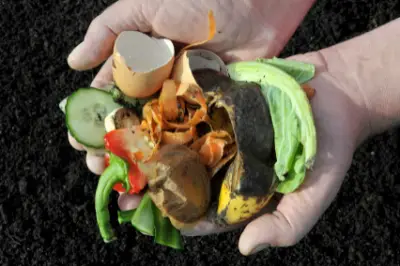
And any other organic waste. Regardless of which you use, green matter is vital to beginning and maintaining the decomposition of your wood chip mulch.
4) Make Your Compost Pile Large
Simply put, larger compost piles work faster than smaller ones. The reason for the effect relates to the importance of heat during composting. Piles with greater volumes are less prone to temperature shifts, meaning that cool outside air is less capable of lowering the temperature of a big compost pile.
Aim to make your compost pile about three to four square feet in size or more. Doing so will help your pile maintain higher heat levels, allowing your wood chips to break down faster than if they were decomposing in a smaller pile or compost bin.
Recommended Compost Thermometers
| Image | Title | Prime | Buy |
|---|---|---|---|
 | REOTEMP Backyard Compost Thermometer - with Digital Composting Guide (Fahrenheit) (16 Inch Stem) | PrimeEligible | Check Price on Amazon |
Top | REOTEMP Backyard Pro Compost Thermometer, 24 Inch Stem, with Digital Composting Guide (0-200 Fahrenheit) | PrimeEligible | Check Price on Amazon |
 | Rukars Compost Thermometer, 20 Inch Stem Backyard Compost Thermometer - 2 Inch Diameter Waterproof Anti-Fog Soil Testing Thermometer with Composting Temperature Guide Zone, 40 to 180 Degrees F | PrimeEligible | Check Price on Amazon |
 | Compost Thermometer - Cate's Garden Premium Stainless Steel Bimetal Thermometer for Backyard Composting - 2 Inch Diameter Fahrenheit / Celsius Dial, 20 Inch Temperature Probe | PrimeEligible | Check Price on Amazon |
 | Long Stem Compost Soil Thermometer - Fast Response Stainless Steel 16 Inch - Fahrenheit and Celsius - Includes Protective Sheath and Composting Guide | PrimeEligible | Check Price on Amazon |
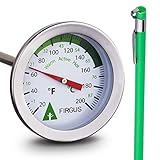 | Firgus Compost Thermometer with 20 Inch Soil Probe for Backyard Composting Stainless Steel 2 Inch Diameter Temperature Gauge and Bonus Stem Protector | PrimeEligible | Check Price on Amazon |
5) Add Fertilizer to Your Wood Chip Compost
Adding fertilizer is another way to quicken composting that many beginner gardeners are unaware of. The right kind of fertilizer can help your composting in more ways than one, which is why you should include fertilization as part of your compost upkeep routine.
Fertilizers can increase the overall nutrient quantity in your compost, making for a better final product. If the fertilizer you use has a high nitrogen ratio, it will speed up your composting as well. As was the case with organic green materials, fertilizers can increase the available nitrogen, which will encourage your compost to break down faster.
Recommended Compost Starter
| Image | Title | Prime | Buy |
|---|---|---|---|
 Top
Top | Jobe's Organics Compost Starter Granules 4 lb. | Prime | Check Price on Amazon |
Top Top
Top | OMRI Listed - Fishnure 8 lb. Organic Humus Compost Fertilizer - sustainably sourced with Living microbes | PrimeEligible | Check Price on Amazon |
 Top
Top | Espoma Organic Traditions Compost Starter- 4 lb Bag BE4 | PrimeEligible | Check Price on Amazon |
 | Roebic CA-1 Bacterial Compost Accelerator, 2.5 LBS | PrimeEligible | Check Price on Amazon |
 Top
Top | Convino: A Compost Starter/ Accelerator. Help to Reduce Kitchen Waste Odor and Convert Yard Waste to Fertile Humus. Comes in 1 Package That Contains 4 Packets Inside | PrimeEligible | Check Price on Amazon |
 | GREEN PIG 60 Accelerator Converts Yard Waste to Fertile Humus in 30 Days and Helps Control Odors Associated with Compost Piles, 1 Bag Dissolvable Packets, White, 12 Count | PrimeEligible | Check Price on Amazon |
6) Keep Your Compost Moist
Along with heat, moisture is another one of the most critical elements in the composting process. During composting, microbes in the pile help to decompose your wood chips. Many of these microorganisms survive best when they have access to a relatively moist environment.
By no means should you take this insight to mean that your compost pile should be always soaking wet. The best approach is to keep your compost pile relatively moist with regular watering. Try wetting your soil once or twice per week, monitoring your pile’s overall moisture, and adjusting accordingly.
Recommended Moisture Meters
| Image | Title | Prime | Buy |
|---|---|---|---|
 Top
Top | 2 Packs Soil Moisture Meter, No Battery Required (Black & Green) | PrimeEligible | Check Price on Amazon |
Top Top
Top | Soil pH Meter 3-in-1 Soil Tester Moisture, Light, pH, Meter Tool for Garden | PrimeEligible | Check Price on Amazon |
 Top
Top | Luxekem Soil Moisture Meter. 4 in 1 Soil Test Kit for House Plants, with 20 Labels | PrimeEligible | Check Price on Amazon |
 Top
Top | HOTWAV Soil Moisture Meter, 3-in-1 Soil Test Kit with Moisture/Light/pH Meter (2 Packs) | PrimeEligible | Check Price on Amazon |
 Top
Top | Soil Moisture Meter-2 Packs Soil Test Kit for Garden-No Battery Needed | PrimeEligible | Check Price on Amazon |
 Top
Top | 5-in-1 Soil pH Meter, with Environmental and Soil Moisture, Temperature, Light and PH Testing Functions | PrimeEligible | Check Price on Amazon |
 Top
Top | XLUX Soil Moisture Meter, No Batteries Required, 2 Pack | PrimeEligible | Check Price on Amazon |
7) Mix Your Wood Chip Compost Pile
Our last piece of advice for composting wood chips fast is to mix your wood compost pile regularly. While compost needs both heat and moisture, those elements are not enough. Aeration through the compost pile is also important to keep the composting process running efficiently.
Mixing your pile also helps to create a more even distribution of heat to your wood chips. As your pile begins to break down, it will generate heat, which will mostly be in the center of the pile. Mixing your compost moves the hotter inner parts of the pile to the outside and helps the cooler parts pick up a bit more heat. In the end, mixing will make for a quicker and more even decomposition of your wood chips.
Recommend Compost Aerators
| Image | Title | Prime | Buy |
|---|---|---|---|
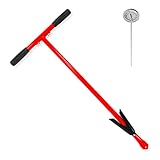 | DOBELIX Compost Aerator - Rust Resistant Composting Aeration Tool with Non-Slip Rubber Grip Handle - Complete with Compost Thermometer | PrimeEligible | Check Price on Amazon |
| Top | Lotech Products Compost Crank Compost Aerator | Prime | Check Price on Amazon |
 | Subpod Compost Aerator. Compost Turner and Mixing Tool That Won't Hurt Your Worms. Crank Compost Aeration Tool. | PrimeEligible | Check Price on Amazon |
| Bosmere Compost Aerator, 36" | Prime | Check Price on Amazon | |
 | EJWOX Compost Turner and Mixing Tool for Outdoor Compost Tumbler Bins,Stainless Steel Manual Rotating Aerator Soil Tiller | PrimeEligible | Check Price on Amazon |
Where to Get Wood Chips
If you would like to create your own wood chip compost but don’t have any wood chips, here is how you can obtain some to compost.
The easiest way to get wood chips is to find a tree service company (or a service like ChipDrop) that will give them to you for free. Many tree services will be happy to drop off a load of wood chips on your driveway. However, this could be a large pile so consider asking your neighbors if they would like to share the wood chips with you.
Another option is to purchase wood chips from a local home improvement store. They can be a little bit expensive, but it’s a great way to get a large quantity all at once.
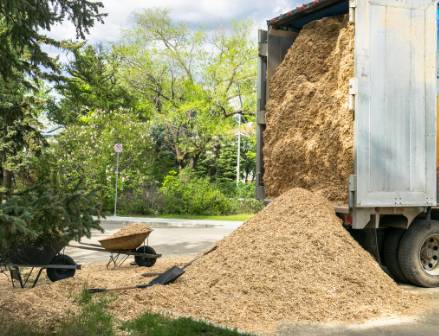
How Long Should It Take to Compost Wood Chips?
Now that you have an idea of the ways you can make your wood chips compost fast, you’re likely wondering exactly how long this process will take. While your results can vary, it’s possible for wood chips to compost in just a few months. The more strategic you are while you plan your compost pile, and the more attentive you are while caring for it, the sooner you can expect your compost to be ready to use.
Benefits of Wood Chip Compost
If you feel discouraged by the work you’ll need to do to compost your wood chips, it helps to keep in mind the many benefits that compost will have on your garden. Here are some of the top positive outcomes you can expect from your wood chip compost that make it well worth the effort:
- Soil Enrichment: Perhaps the most notable benefit of adding wood compost to your vegetable gardens is that it will add a lot of soil organisms and nutrients. Your plants will appreciate these nutrients as they absorb them as fuel and use them to power their most vigorous growth.
- Fewer Harsh Garden Chemicals: When you have fresh compost to use in your garden, you can cut back on the commercial fertilizers you would typically use to support your plants. While these fertilizers have a positive impact in the short term, they can lead to some negative long-term outcomes. Using compost in place of standard fertilizer reduces the number of harmful chemicals that enter the soil.
- Better Soil Structure: Compost not only adds essential nutrients to the soil but also improves the structure of your soil. Wood chip compost helps your soil drain efficiently while holding enough water to keep the soil moist.
- Cost Savings: When your soil needs less fertilizer and can hold water more effectively, you can spend less time with both fertilization and supplemental watering. Over time, using less water and fertilizer means you save a considerable amount of money as well.
- Environmental Benefits: Composting is beneficial not only to you and your garden but also to the broader environment. As we mentioned, compost reduces the need for harmful chemicals. It also adds organic matter that can benefit the entire soil ecosystem, which can have a positive effect on the ecological processes in your area.
It’s clear that using wood compost in your garden has plenty of benefits for your plants and the soil itself. However, you cannot reap any of these benefits if you have no idea how to apply wood chip compost to your garden soil.
How to Use Wood Chip Compost in Your Garden
Before we end this article, we want to give you some more practical advice on how to use your wood chip compost in your garden. Assuming you were successful in completing the steps we laid out earlier, here are some of the ways you can improve your soil with compost:
- Use Compost as a Topdressing: Spread a thin layer of compost on top of the existing soil in your garden. Over time, the compost will seep into the soil, where it can benefit your plants.
- Mixing Compost into the Soil: Begin by loosening the first few inches of soil in your planting bed. Then, add compost and rake it to incorporate it down into the soil.
- Adding Compost to Containers: There is no reason you can’t add compost to your container plants as well. In this case, a small sprinkling of compost can act as an effective topdressing.
With those few simple steps, you can add compost to your garden that your plants will love. And now that you know how to make compost as well as how to use it, there’s no reason not to start a wood chip compost pile in your yard.
Final Thoughts
Composting wood chips will take time and effort no matter what method you choose to use. However, if speed is your goal, you should have a good idea of what steps you can take to make your wood chips break down as quickly as they can. If you follow all of our tips, you’re sure to find your wood chip compost is ready to use much sooner than you once might have expected.

John Haryasz is a freelance writer and landscape designer. In the field of landscape architecture, he has contributed to many successful design projects throughout the country. As a writer, John specializes in creating captivating and informative web content. Through that work, he aims to share his design knowledge and promote engagement with the outdoor world.

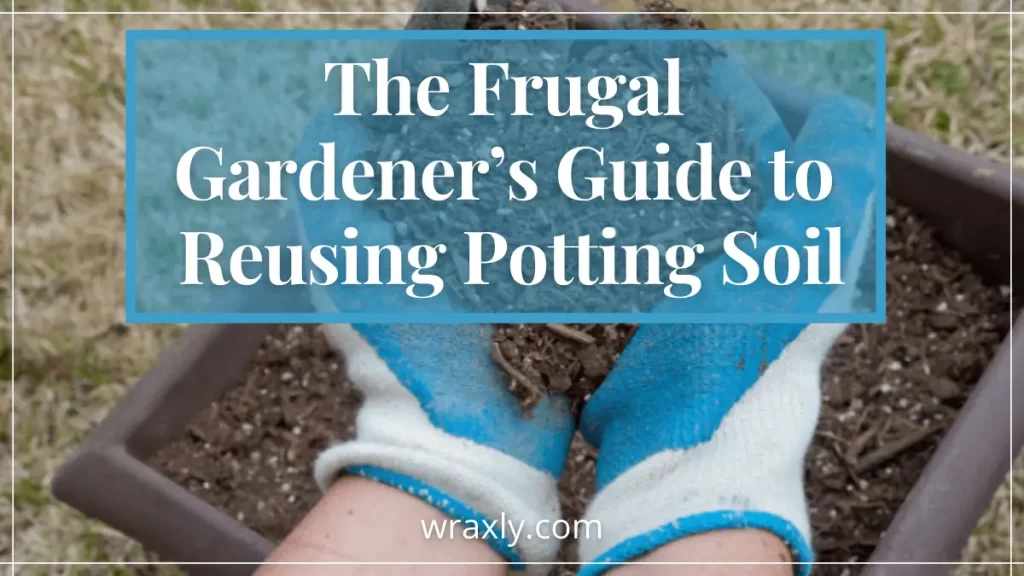

![10 Common Container Garden Mistakes to Avoid [Beginner’s Guide]](https://wraxly.com/wp-content/uploads/2021/02/10-Common-Container-Garden-Mistakes-to-Avoid-Beginners-Guide-1200-1024x576.webp)